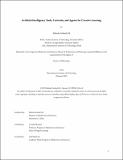Artificial Intelligence Tools, Curricula, and Agents for Creative Learning
Author(s)
Ali, Safinah Arshad
DownloadThesis PDF (69.81Mb)
Advisor
Breazeal, Cynthia
Terms of use
Metadata
Show full item recordAbstract
Children's early development of creativity contributes to their learning outcomes and personal growth. However, as children enter formal schooling systems, their creativity declines. Although Artificial Intelligence (AI)-powered tools for K-12 learning hold immense potential for reducing barriers to creative expression, access to these AI tools and AI knowledge among K-12 students and educators remains inequitable to children from groups underrepresented in STEM. In this thesis, I explore how AI, as an emerging creative medium, can be made more accessible to all young creators. I explore two mechanisms of making a mode of creation more accessible: Creative AI literacy materials for diverse classrooms and AI agentic interactions for scaffolding creative expression for diverse learners.
Utilizing literacy as a mode of making Creative AI tools accessible, I outline the design and evaluation of various Creative AI curricula that I have developed for diverse groups of K-12 students and teachers. To adapt AI learning to art classrooms, I co-developed the AI and Art curriculum with creative educators, designed specifically for use in creative classrooms with creative educators and learners. I implemented the curriculum with 94 middle and high school students across six week-long sessions. I report findings from teacher co-design sessions and students’ learning experiences. Teachers designed learning objectives and AI tools for their classrooms. Students gained knowledge and skills in art concepts, AI concepts, and the application of art in AI. Students also demonstrated significant shifts in their attitudes towards using AI in the creative process, and their sense of belonging in both AI and art communities was heightened. I discuss how AI curricula can be adapted to diverse disciplines and how art can serve as a meaningful avenue for students to engage with AI concepts.
Utilizing social interaction from AI agents as a mode of fostering creative expression in children with neurodevelopmental disorders, I designed and applied inclusive child-robot interactions for collaborative creativity, where 32 elementary school children and a social robot collaboratively created picture stories. The robot provided creativity scaffolding during different parts of the creative storytelling process through social interactions such as feedback, question-asking, divergent thinking, and positive reinforcement, while personalizing the scaffolding to meet the unique needs of neurodivergent children. I investigated the impact of the social robot on children’s exhibited creativity and their emergent creative collaborative interactions in storytelling over multiple sessions. Inclusive design practices eliminated creative barriers for children with neurodevelopmental disorders, and the robot's creativity scaffolding interactions positively influenced children’s creative product and creative process in storytelling. I propose Inclusive Co-creative Child-robot Interaction (ICCRI) guidelines for fostering creativity in children with neurodevelopmental disorders, and accommodating diverse creator styles in complex, open-ended creative tasks.
In this thesis, I contribute curricula, learning tools, child-robot interactions, and findings from examining long-term child-AI co-creative interactions. I discuss design implications for integrating AI tools, curricula and agents in creative learning environments. This thesis is a step towards empowering all children with powerful modes of creation, while helping them be responsible creators, thinkers and citizens in an AI-driven future.
Date issued
2025-02Department
Program in Media Arts and Sciences (Massachusetts Institute of Technology)Publisher
Massachusetts Institute of Technology